Mapping Forest Vertical Structure in Gong-ju, Korea Using Sentinel-2 Satellite Images and Artificial Neural Networks
Abstract
1. Introduction
2. Study Area and Data
3. Methodology
3.1. Preprocessing of Input Layers
3.1.1. Preprocessed Layers of Sentinel-2 Images
3.1.2. Canopy Height Maps from DSM and DTM
3.2. Application of Artificial Neural Network
4. Results
4.1. Results Maps from Preprocessing
4.2. Results from Artificial Neural Network
5. Conclusions
Author Contributions
Funding
Conflicts of Interest
References
- Luo, P.; Zhou, M.; Deng, H.; Lyu, J.; Cao, W.; Takara, K.; Nover, D.; Schladow, S.G. Impact of forest maintenance on water shortages: Hydrologic modeling and effects of climate change. Sci. Total Environ. 2018, 615, 1355–1363. [Google Scholar] [CrossRef] [PubMed]
- Keleş, S. An assessment of hydrological functions of forest ecosystems to support sustainable forest management. J. Sustain. For. 2019, 38, 305–326. [Google Scholar] [CrossRef]
- Terêncio, D.; Fernandes, L.S.; Cortes, R.; Moura, J.; Pacheco, F. Rainwater harvesting in catchments for agro-forestry uses: A study focused on the balance between sustainability values and storage capacity. Sci. Total Environ. 2018, 613, 1079–1092. [Google Scholar] [CrossRef] [PubMed]
- Creed, I.F.; Jones, J.J.; Archer Van Garderen, E.; Claassen, M.; Ellison, D.; McNulty, S.G.; Van Noordwijk, M.; Vira, B.; Wei, X.; Bishop, K. Managing Forests for Both Downstream and Downwind Water. Front. For. Glob. Chang. 2019, 2, 64. [Google Scholar] [CrossRef]
- Sun, J.; Yu, X.; Wang, H.; Jia, G.; Zhao, Y.; Tu, Z.; Deng, W.; Jia, J.; Chen, J. Effects of forest structure on hydrological processes in China. J. Hydrol. 2018, 561, 187–199. [Google Scholar] [CrossRef]
- Murai, T.; Andrews, J.W. Interactions of dietary α-tocopherol, oxidized menhaden oil and ethoxyquin on channel catfish (Ictalurus punctatus). J. Nutr. 1974, 104, 1416–1431. [Google Scholar] [CrossRef]
- Yu, Z.; Liu, S.; Wang, J.; Wei, X.; Schuler, J.; Sun, P.; Harper, R.; Zegre, N. Natural forests exhibit higher carbon sequestration and lower water consumption than planted forests in China. Glob. Chang. Biol. 2019, 25, 68–77. [Google Scholar] [CrossRef]
- Clark, M.L.; Buck-Diaz, J.; Evens, J. Mapping of forest alliances with simulated multi-seasonal hyperspectral satellite imagery. Remote Sens. Environ. 2018, 210, 490–507. [Google Scholar] [CrossRef]
- Morin, D.; Planells, M.; Guyon, D.; Villard, L.; Mermoz, S.; Bouvet, A.; Thevenon, H.; Dejoux, J.-F.; Le Toan, T.; Dedieu, G. Estimation and Mapping of Forest Structure Parameters from Open Access Satellite Images: Development of a Generic Method with a Study Case on Coniferous Plantation. Remote Sens. 2019, 11, 1275. [Google Scholar] [CrossRef]
- Taureau, F.; Robin, M.; Proisy, C.; Fromard, F.; Imbert, D.; Debaine, F. Mapping the mangrove forest canopy using spectral unmixing of very high spatial resolution satellite images. Remote Sens. 2019, 11, 367. [Google Scholar] [CrossRef]
- Liu, J.; Zhang, Z.; Zhang, M. Impacts of forest structure on precipitation interception and run-off generation in a semiarid region in northern China. Hydrol. Process. 2018, 32, 2362–2376. [Google Scholar] [CrossRef]
- Cho, H.; Lee, K.-S. Comparison between hyperspectral and multispectral images for the classification of coniferous species. Korean J. Remote Sens. 2014, 30, 25–36. [Google Scholar] [CrossRef]
- Kriegler, F.; Malila, W.; Nalepka, R.; Richardson, W. Preprocessing Transformations and Their Effects on Multispectral Recognition. In Proceedings of the Sixth International Symposium on Remote Sensing of Environment, Ann Arbor, MI, USA, 13–16 October 1969; p. 97. [Google Scholar]
- Gao, B.-C. NDWI—A normalized difference water index for remote sensing of vegetation liquid water from space. Remote Sens. Environ. 1996, 58, 257–266. [Google Scholar] [CrossRef]
- Delegido, J.; Verrelst, J.; Alonso, L.; Moreno, J. Evaluation of sentinel-2 red-edge bands for empirical estimation of green LAI and chlorophyll content. Sensors 2011, 11, 7063–7081. [Google Scholar] [CrossRef] [PubMed]
- Lee, B.; Kim, E.S.; Lee, J.-S.; Jung, J.; Lim, J.H. Detecting Phenology Using MODIS Vegetation Indices and Forest Type Map in South Korea. Korean J. Remote Sens. 2018, 34, 267–282. [Google Scholar]
- Herrmann, I.; Pimstein, A.; Karnieli, A.; Cohen, Y.; Alchanatis, V.; Bonfil, D. LAI assessment of wheat and potato crops by VENμS and Sentinel-2 bands. Remote Sens. Environ. 2011, 115, 2141–2151. [Google Scholar] [CrossRef]
- Hay, G.; Niemann, K.; McLean, G. An object-specific image-texture analysis of H-resolution forest imagery. Remote Sens. Environ. 1996, 55, 108–122. [Google Scholar] [CrossRef]
- Morsdorf, F.; Mårell, A.; Koetz, B.; Cassagne, N.; Pimont, F.; Rigolot, E.; Allgöwer, B. Discrimination of vegetation strata in a multi-layered Mediterranean forest ecosystem using height and intensity information derived from airborne laser scanning. Remote Sens. Environ. 2010, 114, 1403–1415. [Google Scholar] [CrossRef]
- Mund, J.-P.; Wilke, R.; Körner, M.; Schultz, A. Detecting multi-layered forest stands using high density airborne LiDAR data. J. Geogr. Inf. Sci. 2015, 1, 178–188. [Google Scholar] [CrossRef]
- Zimble, D.A.; Evans, D.L.; Carlson, G.C.; Parker, R.C.; Grado, S.C.; Gerard, P.D. Characterizing vertical forest structure using small-footprint airborne LiDAR. Remote Sens. Environ. 2003, 87, 171–182. [Google Scholar] [CrossRef]
- Kwon, S.-K.; Jung, H.-S.; Baek, W.-K.; Kim, D. Classification of forest vertical structure in south Korea from aerial orthophoto and lidar data using an artificial neural network. Appl. Sci. 2017, 7, 1046. [Google Scholar] [CrossRef]
- Sadeghi, Y.; St-Onge, B.; Leblon, B.; Simard, M. Canopy height model (CHM) derived from a TanDEM-X InSAR DSM and an airborne lidar DTM in boreal forest. IEEE J. Sel. Top. Appl. Earth Obs. Remote Sens. 2016, 9, 381–397. [Google Scholar] [CrossRef]
- Fu, H.; Wang, C.; Zhu, J.; Xie, Q.; Zhang, B. Estimation of pine forest height and underlying DEM using multi-baseline P-band PolInSAR data. Remote Sens. 2016, 8, 820. [Google Scholar] [CrossRef]
- Sun, G.; Ranson, K.; Kimes, D.; Blair, J.; Kovacs, K. Forest vertical structure from GLAS: An evaluation using LVIS and SRTM data. Remote Sens. Environ. 2008, 112, 107–117. [Google Scholar] [CrossRef]
- Lary, D.J.; Alavi, A.H.; Gandomi, A.H.; Walker, A.L. Machine learning in geosciences and remote sensing. Geosci. Front. 2016, 7, 3–10. [Google Scholar] [CrossRef]
- Li, W.; Cao, S.; Campos-Vargas, C.; Sanchez-Azofeifa, A. Identifying tropical dry forests extent and succession via the use of machine learning techniques. Int. J. Appl. Earth Obs. Geoinf. 2017, 63, 196–205. [Google Scholar] [CrossRef]
- Stojanova, D.; Panov, P.; Gjorgjioski, V.; Kobler, A.; Džeroski, S. Estimating vegetation height and canopy cover from remotely sensed data with machine learning. Ecol. Inform. 2010, 5, 256–266. [Google Scholar] [CrossRef]
- Zhao, K.; Popescu, S.; Meng, X.; Pang, Y.; Agca, M. Characterizing forest canopy structure with lidar composite metrics and machine learning. Remote Sens. Environ. 2011, 115, 1978–1996. [Google Scholar] [CrossRef]
- Bazi, Y.; Melgani, F. Toward an optimal SVM classification system for hyperspectral remote sensing images. IEEE Trans. Geosci. Remote Sens. 2006, 44, 3374–3385. [Google Scholar] [CrossRef]
- Yuan, H.; Yang, G.; Li, C.; Wang, Y.; Liu, J.; Yu, H.; Feng, H.; Xu, B.; Zhao, X.; Yang, X. Retrieving soybean leaf area index from unmanned aerial vehicle hyperspectral remote sensing: Analysis of RF, ANN, and SVM regression models. Remote Sens. 2017, 9, 309. [Google Scholar] [CrossRef]
- Belgiu, M.; Drăguţ, L. Random forest in remote sensing: A review of applications and future directions. ISPRS J. Photogramm. Remote Sens. 2016, 114, 24–31. [Google Scholar] [CrossRef]
- Ashby, J.; Moreno-Madriñán, M.J.; Yiannoutsos, C.T.; Stanforth, A. Niche modeling of dengue fever using remotely sensed environmental factors and boosted regression trees. Remote Sens. 2017, 9, 328. [Google Scholar] [CrossRef]
- Ghatkar, J.G.; Singh, R.K.; Shanmugam, P. Classification of algal bloom species from remote sensing data using an extreme gradient boosted decision tree model. Int. J. Remote Sens. 2019, 40, 9412–9438. [Google Scholar] [CrossRef]
- National Institute of Ecology. The 3rd National Natural Environment Survey, 3rd ed.; National Natural Environment Survey: Seoul, Korea, 2009.
- Drusch, M.; Del Bello, U.; Carlier, S.; Colin, O.; Fernandez, V.; Gascon, F.; Hoersch, B.; Isola, C.; Laberinti, P.; Martimort, P. Sentinel-2: ESA’s optical high-resolution mission for GMES operational services. Remote Sens. Environ. 2012, 120, 25–36. [Google Scholar] [CrossRef]
- Kwon, S.-K. Classification of Natural Forest/Artificial Forest from Sentinel-2 Images Using Artificial Neural Network; University of Seoul: Seoul, Korea, 2018. [Google Scholar]
- Teillet, P.; Guindon, B.; Goodenough, D. On the slope-aspect correction of multispectral scanner data. Can. J. Remote Sens. 1982, 8, 84–106. [Google Scholar] [CrossRef]
- McFeeters, S.K. The use of the Normalized Difference Water Index (NDWI) in the delineation of open water features. Int. J. Remote Sens. 1996, 17, 1425–1432. [Google Scholar] [CrossRef]
- Barnes, E.; Clarke, T.; Richards, S.; Colaizzi, P.; Haberland, J.; Kostrzewski, M.; Waller, P.; Choi, C.; Riley, E.; Thompson, T. Coincident Detection of Crop Water Stress, Nitrogen Status and Canopy Density Using Ground Based Multispectral Data. In Proceedings of the Fifth International Conference on Precision Agriculture, Bloomington, MN, USA, 16–19 July 2000. [Google Scholar]
- Gitelson, A.; Merzlyak, M.N. Spectral reflectance changes associated with autumn senescence of Aesculus hippocastanum L. and Acer platanoides L. leaves. Spectral features and relation to chlorophyll estimation. J. Plant Physiol. 1994, 143, 286–292. [Google Scholar] [CrossRef]
- Yoon, S.; Lee, S.; Park, K.; Jang, S.; Rhee, J. Development of a Storage Level and Capacity Monitoring and Forecasting Techniques in Yongdam Dam Basin Using High Resolution Satellite Image. J. Korean J. Remote Sens. 2018, 34, 1041–1053. [Google Scholar]
- Yang, C.; Lu, L.; Lin, H.; Guan, R.; Shi, X.; Liang, Y. A fuzzy-statistics-based principal component analysis (FS-PCA) method for multispectral image enhancement and display. IEEE Trans. Geosci. Remote Sens. 2008, 46, 3937–3947. [Google Scholar] [CrossRef]
- Lillesand, T.M.; Kiefer, R.W.; Chipman, J. Remote Sensing and Image Interpretation; John Willey & Sons: New York, NY, USA, 2000; p. 724. [Google Scholar]
- Lee, Y.-S.; Park, S.-H.; Jung, H.-S.; Baek, W.-K. Classification of Natural and Artificial Forests from KOMPSAT-3/3A/5 Images Using Artificial Neural Network. Korean J. Remote Sens. 2018, 34, 1399–1414. [Google Scholar]
- Hwang, J.-I.; Jung, H.-S. Automatic ship detection using the artificial neural network and support vector machine from X-band SAR satellite images. Remote Sens. 2018, 10, 1799. [Google Scholar] [CrossRef]
- Witten, I.H.; Frank, E.; Hall, M.A.; Pal, C. Data Mining: Practical Machine Learning Tools and Techniques; Morgan Kaufmann: Burlington, MA, USA, 2016. [Google Scholar]
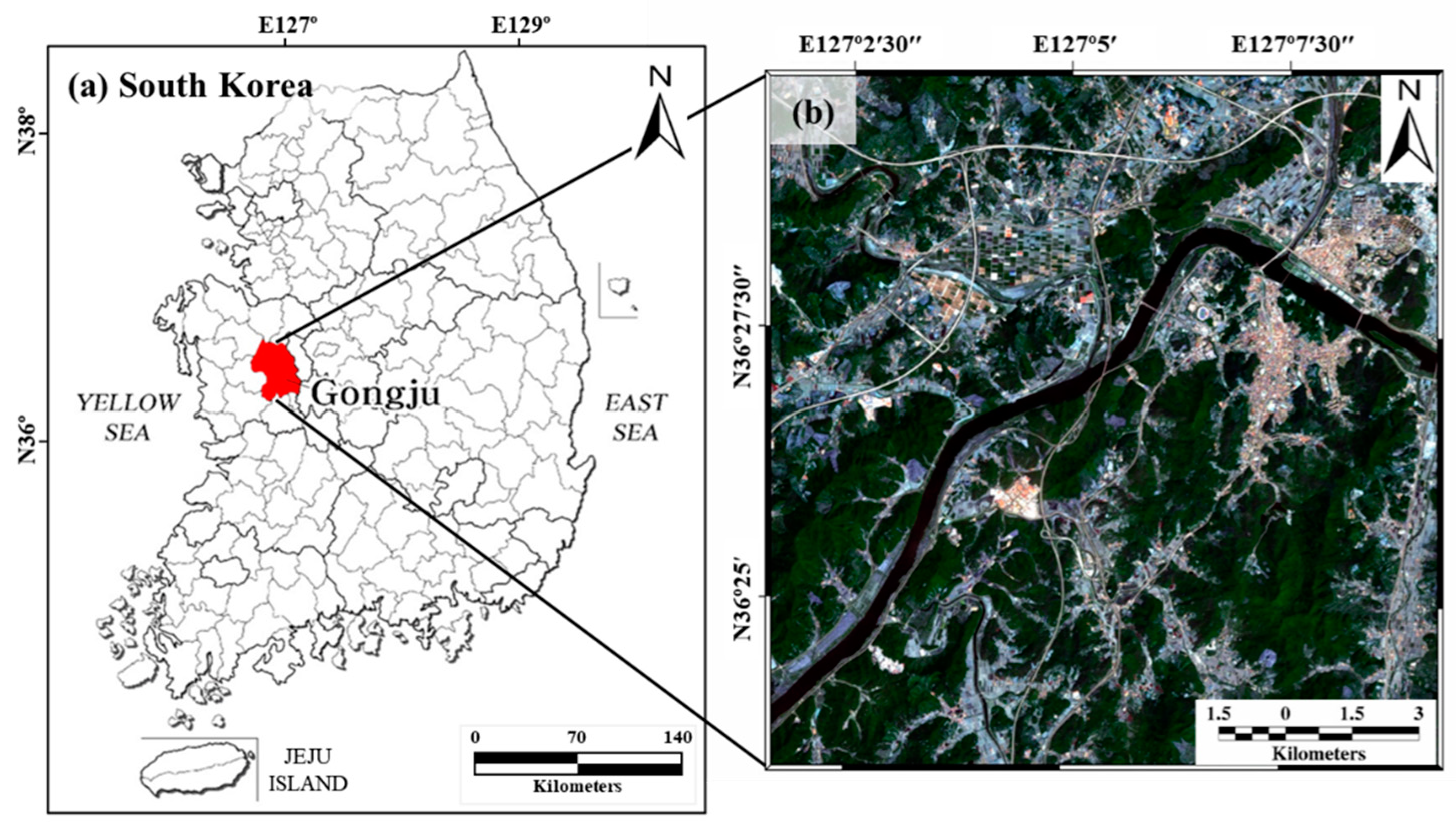


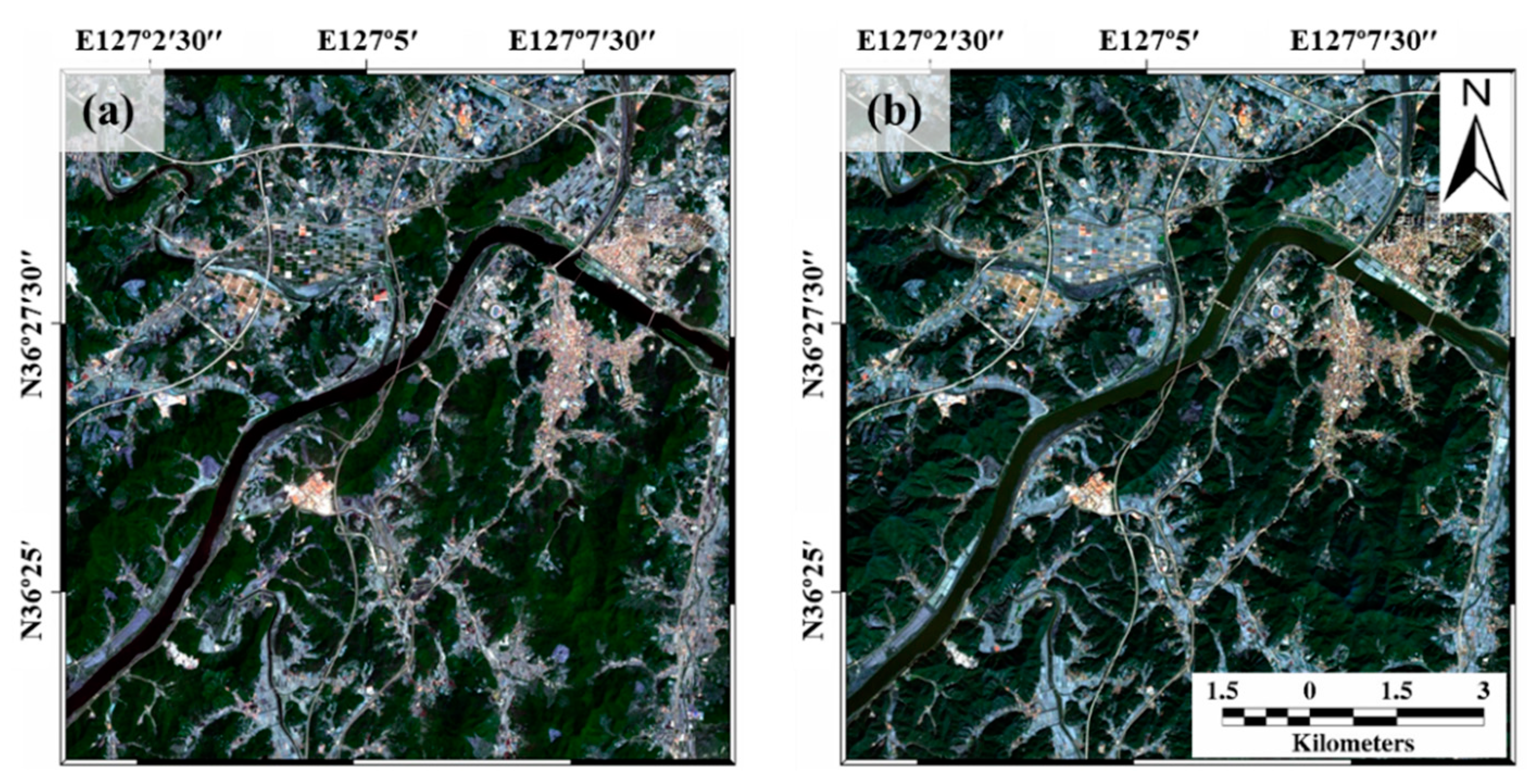
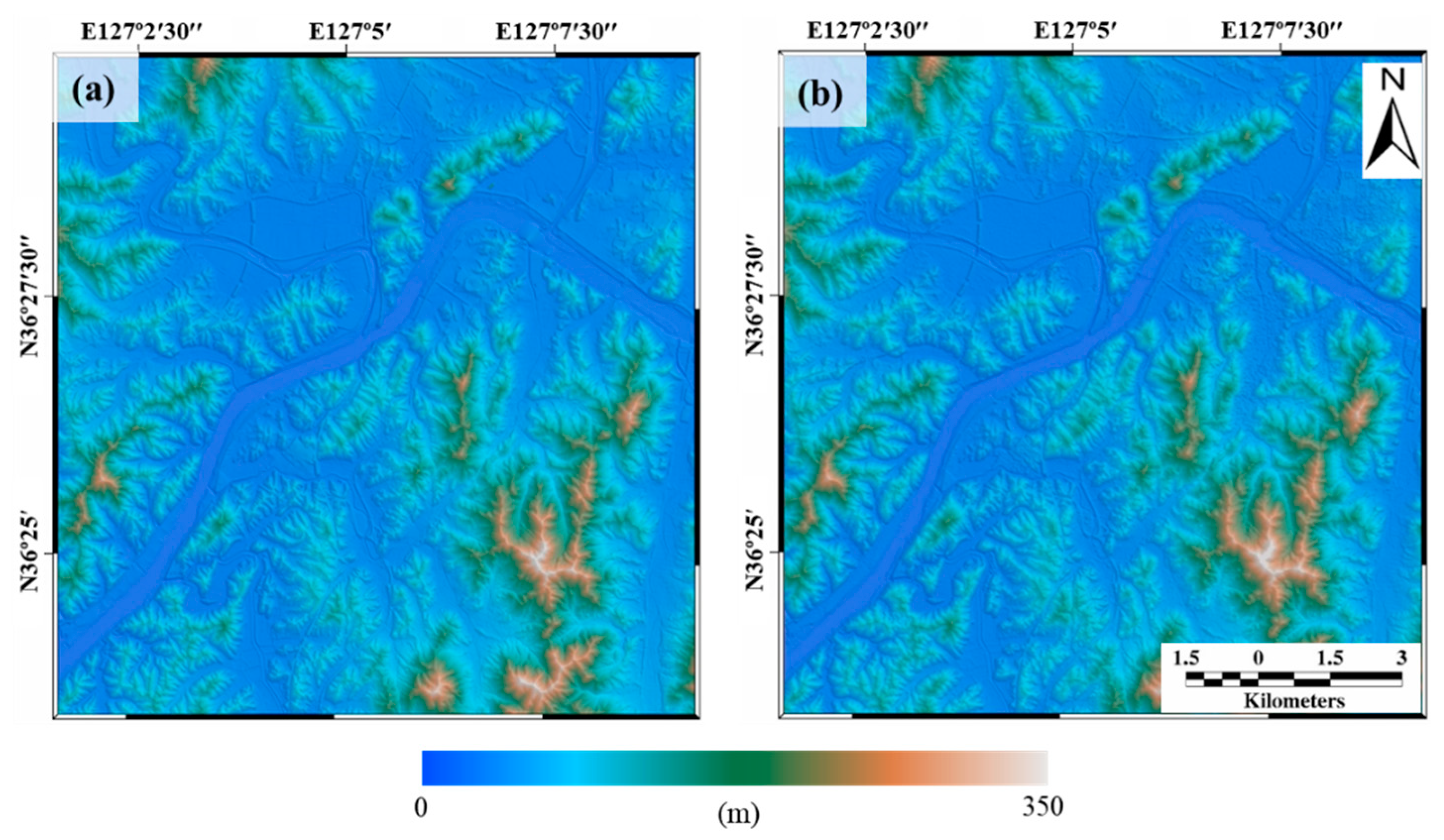

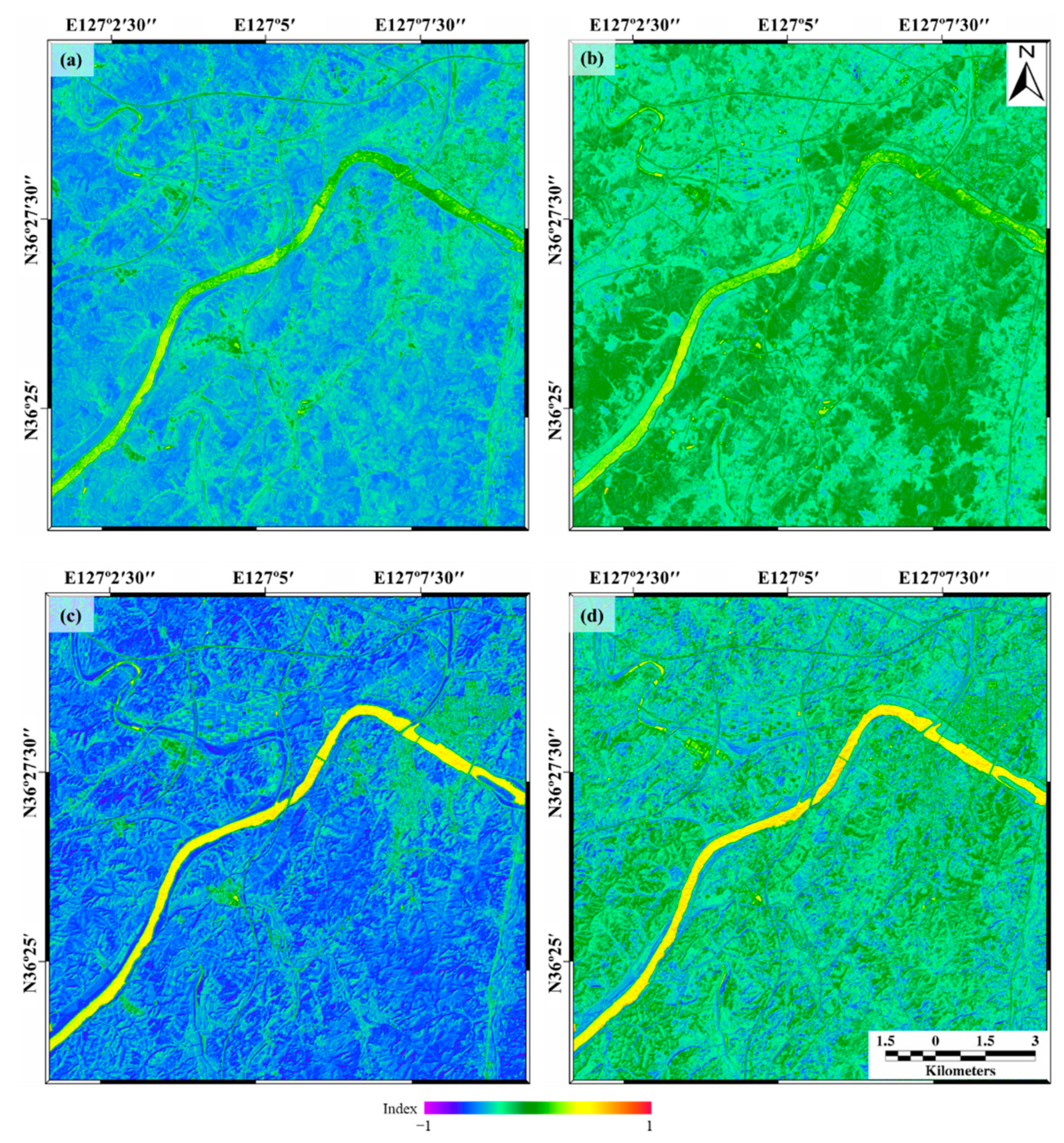

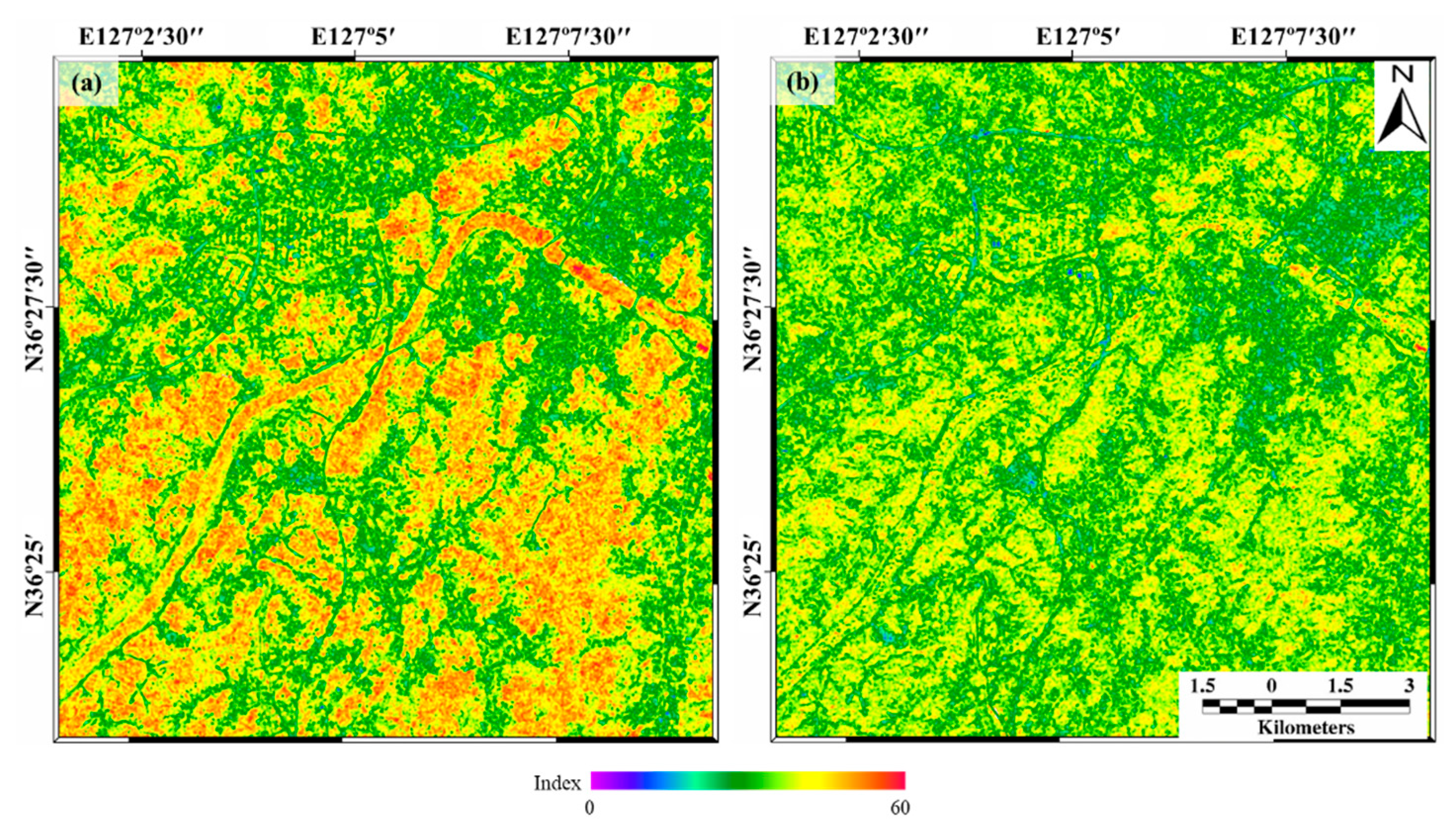
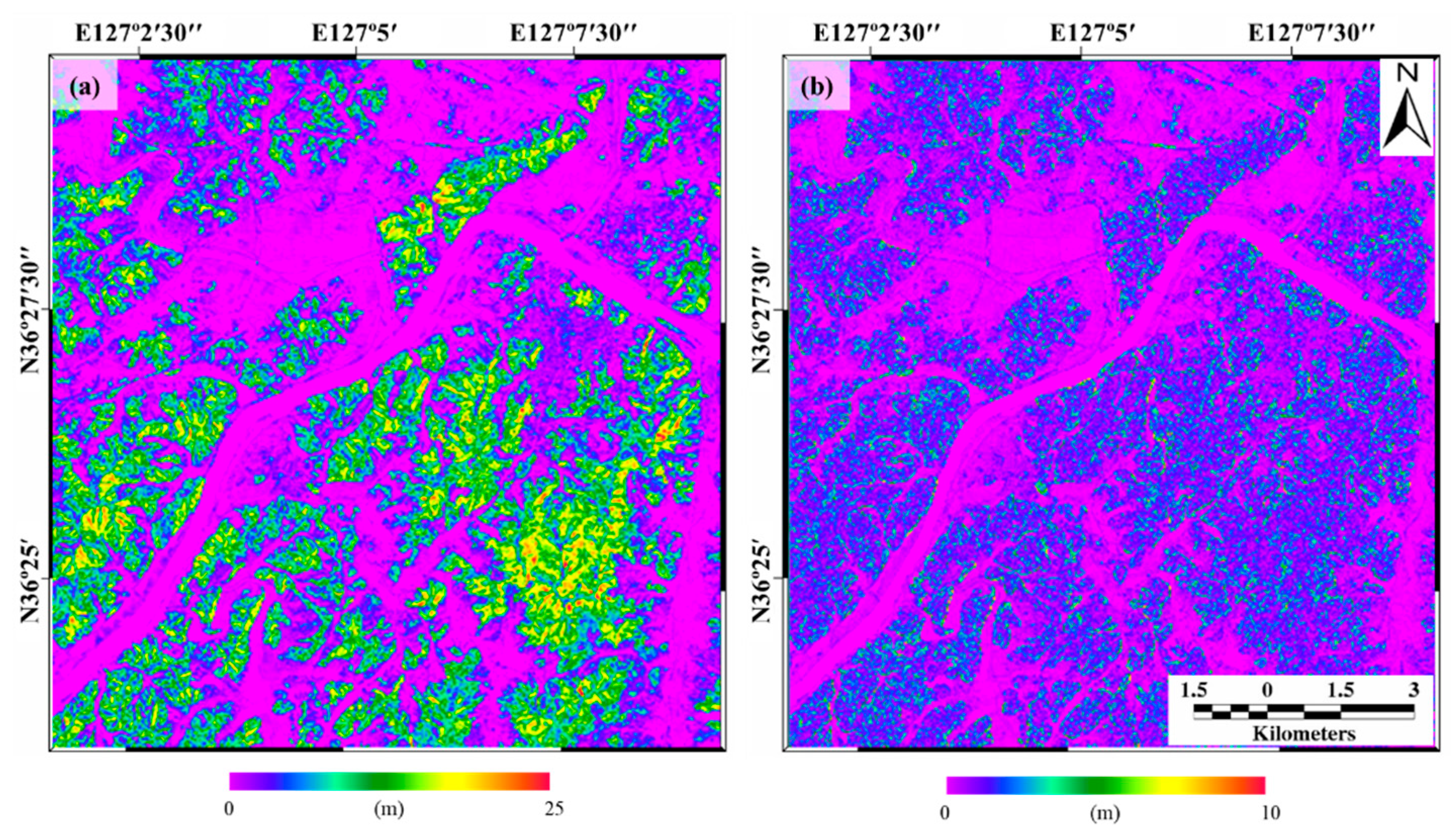



| Parameters | Spring | Fall |
|---|---|---|
| Date (YYYY.MM.DD) | 2017.05.03 | 2017.10.30 |
| Ground sample distance (m) | 10 | 10 |
| Sun altitude angle (deg.) | 65.3 | 38.5 |
| Sun azimuth angle (deg.) | 143.5 | 165.5 |
| Sentinel-2 Bands | Central Wavelength (nm) | Band Width (nm) | Spatial Resolution (m) |
|---|---|---|---|
| 3 (Green) | 560 | 35 | 10 |
| 4 (Red) | 665 | 30 | 10 |
| 5 (Vegetation red edge) | 705 | 15 | 20 |
| 6 (Vegetation red edge) | 740 | 15 | 20 |
| 7 (Vegetation red edge) | 783 | 20 | 20 |
| 8 (NIR) | 842 | 115 | 10 |
| 11 (SWIR) | 1610 | 90 | 20 |
| 12 (SWIR) | 2190 | 180 | 20 |
| Reference | Single Layer | Double Layer | Triple Layer | Total | User Accuracy (%) | |
|---|---|---|---|---|---|---|
| ANN | ||||||
| Single Layer | 71,952 | 9,904 | 59,110 | 140,966 | 51.04% | |
| Double Layer | 15,421 | 20,170 | 66,624 | 102,215 | 19.73% | |
| Triple Layer | 40,069 | 49,886 | 356,398 | 446,353 | 79.85% | |
| Total | 127,442 | 79,960 | 482,132 | 689,534 | ||
| Producer accuracy (%) | 56.46% | 25.23% | 73.92% | |||
| Overall accuracy (%) | 65.06% | |||||
© 2020 by the authors. Licensee MDPI, Basel, Switzerland. This article is an open access article distributed under the terms and conditions of the Creative Commons Attribution (CC BY) license (http://creativecommons.org/licenses/by/4.0/).
Share and Cite
Lee, Y.-S.; Lee, S.; Jung, H.-S. Mapping Forest Vertical Structure in Gong-ju, Korea Using Sentinel-2 Satellite Images and Artificial Neural Networks. Appl. Sci. 2020, 10, 1666. https://doi.org/10.3390/app10051666
Lee Y-S, Lee S, Jung H-S. Mapping Forest Vertical Structure in Gong-ju, Korea Using Sentinel-2 Satellite Images and Artificial Neural Networks. Applied Sciences. 2020; 10(5):1666. https://doi.org/10.3390/app10051666
Chicago/Turabian StyleLee, Yong-Suk, Sunmin Lee, and Hyung-Sup Jung. 2020. "Mapping Forest Vertical Structure in Gong-ju, Korea Using Sentinel-2 Satellite Images and Artificial Neural Networks" Applied Sciences 10, no. 5: 1666. https://doi.org/10.3390/app10051666
APA StyleLee, Y.-S., Lee, S., & Jung, H.-S. (2020). Mapping Forest Vertical Structure in Gong-ju, Korea Using Sentinel-2 Satellite Images and Artificial Neural Networks. Applied Sciences, 10(5), 1666. https://doi.org/10.3390/app10051666






